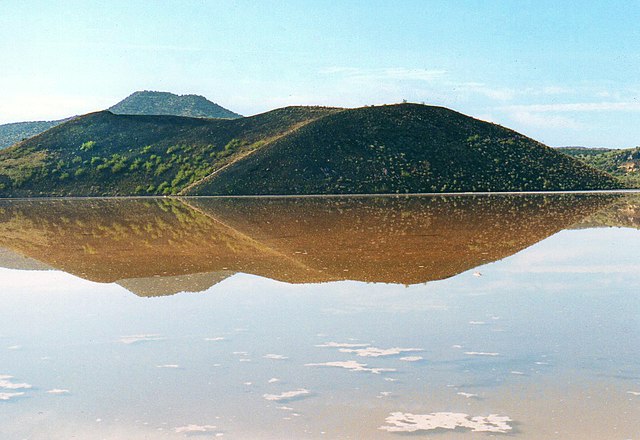The National Oceanic and Atmospheric Administration’s scientists last summer noticed dust drifting 85 miles from Lake Abert and Summer Lake, two depleted salt lakes in southern Oregon.
Saline lakebeds are among the major producers of dust in the West; this has happened previously. The 800 square miles of the Great Salt Lake’s exposed bed have produced toxin-filled dust storms in Salt Lake City, while California’s Owens Lake is the country’s largest source of PM10, the microscopic pollutants found in dust and smoking.
Saline lakes are some of the West’s most endangered ecosystems as a result of climate change, agricultural usage, and urban development. New law is now providing some assistance. The bipartisan Saline Lake Ecosystems in the Great Basin States Program Act, which allots $25 million in funding for research and monitoring at saline lakes throughout the Great Basin, was signed by President Joe Biden on December 27. Although this investment is a significant start, it cannot provide the lakes with more water, which is what they actually need.

Salt lakes are frequently found in the Interior West because snowmelt collects in the Basin and Range region’s valley bottoms. Since the valleys don’t have an exit, the water stays there until it evaporates, leaving the suspended particles behind. As they build up over time, the lakes become highly salinized.
Ryan Houston, executive director of the Oregon Natural Desert Association, which works to protect Oregon’s high desert, including Summer Lake and Lake Abert, said that it “creates a unique system that supports brine shrimp and alkali flies that may feed enormous populations of migratory birds.”
The balance between evaporation, runoff, and salts also makes saline lakes particularly vulnerable to climate change. Higher temperatures cause the snowpack to shrink and evaporation to increase, which results in less water in the lakes and a higher salt content. It also exposes dry lakebeds, resulting in hazardous dust storms, which stresses shrimp and flies, which have evolved over time to thrive in particular salinities.
The water from the lakes has also been diverted for municipal and agricultural use over the years. For example, since its water was diverted to Los Angeles, California’s Owens Lake has been almost entirely dry for almost a century. The Great Salt Lake is on course to disappear within five years, according to a report published this month by Utah scientists and environmental groups. This is because of water diversions and climate change, the research warned.

Many people consider the major justification for preserving the lakes to be bad air quality. However, the dust is a warning that the ecology as a whole is deteriorating. Saline lakes are important resting places for birds traveling through the Pacific Flyway, which connects Alaska with Patagonia, Chile. Houston asserted that the point at which Lake Abert’s most significant ecological value—being lost as a component of the Pacific Flyway—has already passed. 338 bird species depend on the Great Salt Lake, and over 80 species of birds either live in or migrate through Lake Abert.
The Great Salt Lake, Lake Abert, Summer Lake, the Owens and Mono lakes in California, and the Ruby and Walker lakes in Nevada are just a few of the salt lakes that will be the subject of the new legislation’s research and monitoring program. David Herbst, a biologist who started working at Mono Lake in the 1970s, claims that additional oversight by federal and state organizations is urgently needed because only a “small core of scientists” work on saline lakes.
The act is significant, according to Geoffrey McQuilkin, executive director of the Mono Lake Committee, “because it funds scientific study that will inform how to sustainably manage valuable habitats to retain their numerous advantages in the age of climate change,” he wrote in an email. Klamath Tribes tribe chairman Clayton Dumont remarked, “We’re pleased to see anything that will assist restore that unique ecology.” The Klamath Tribes’ traditional land surrounds Lake Abert.

This is hardly the first federal initiative to support lakes. The 2002 Desert Terminal Lakes Program allocated more than $200 million to fund scientific study and the acquisition of water rights in order to help the conservation of Nevada’s saline lakes. Just two weeks ago, a $858 billion defense budget package that included $10 million for Army Corps of Engineers programs connected to saline lakes was approved. Additionally, the Great Salt Lake Watershed Enhancement Act of 2022 in Utah established a $40 million fund for lake conservation.
However, some supporters claim that monitoring and study are insufficient. This is fantastic! However, it doesn’t supply water to Great Salt Lake, according to a statement made on Instagram by the group Save Our Great Salt Lake after the Senate passed the legislation.
Refilling the lakes is a difficult topic. States regulate water rights, making it more difficult for the federal government to intervene. Houston added, “The federal government and other scientists may step in and provide a tremendous lot of support and information that advocates can utilize for lakes where basic measurement, basic monitoring, and some of the basic science is lacking.
However, most people are optimistic now that the lakes are receiving greater attention. Houston stated, “Unfortunately, there’s a crisis, so it’s an exciting time. But a lot of people are talking about it, so it’s an exciting time.
Download The Radiant App To Start Watching!
Web: Watch Now
LGTV™: Download
ROKU™: Download
XBox™: Download
Samsung TV™: Download
Amazon Fire TV™: Download
Android TV™: Download

